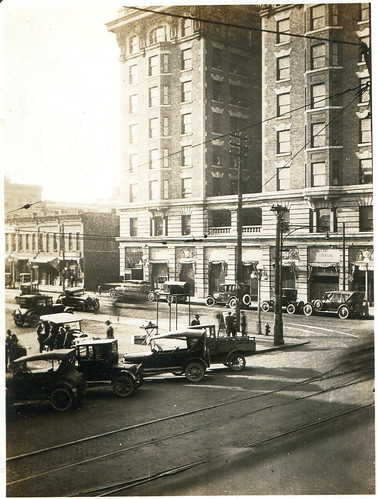When construction on New York’s iconic triangular Flatiron building was completed, pedestrians noticed that the shape and location of the building created strong, gusty winds. In 1907, Joplin residents experienced their own version of the Flatiron’s freak winds.
After the completion of the New Joplin Hotel (later known as the Connor Hotel) at the corner of Fourth and Main streets, strong winds wreaked havoc upon all who dared to pass by. As a reporter observed, on “calm, still days the wind blows in savage gusts around the corner of the new hotel at Fourth and Main and on windy days a veritable hurricane rages up and down Main street and the side streets that lead to Joplin’s ‘flatiron’ corner.”
He described the daily scenes as thus, “All the sights that are seen in New York on a windy day may be seen at the corner of Fourth and Main streets. The variegated display of hosiery, coattails flapping in the ungentle zephyrs, men chasing their hats, and everybody walking either like they were drawing a heavy loaded cart or if they chance to be going with the wind, moving with accelerate step, may be seen.”
On one day blustery day, the wind blew twenty wagon loads of dry sand up and down the nearby streets. The sand, which was to be used on the hotel site, was a total loss. “Flags and banners put up around the corner were whipped into threads by the blowing wind, and loosely nailed board signs were hurled to the street.” Women and girls held onto their skirts to keep them from blowing up and were forced to fix their hair after passing through the area. Men quickly learned to remove their hats, lest it be blown away, as with one man who watched as his prized hat was snatched by a young dog as the hat rolled down the street. One African American workman claimed that the wind was so fierce that he had been pinned up against the building.
The reporter remarked to a nearby workman about the wasted sand, but the workman just shook his head. “No; it isn’t that, but how do you think we can get men to pay strict attention to their work when there are so many funny sights in the street below?”
The wind held the advantage of surprise. It was not a steady, consistent wind. Instead, it gusted in sporadic bursts that caught pedestrians by surprise. “When the wind is from the south in most parts of town, it may be blowing from the north at Joplin’s ‘flatiron corner.’” In one case, a horse powered delivery wagon became unmanageable due to the wind. The young boy in charge of the wagon tried to hold on to both his hat and the horse, but as he did so, he accidentally backed the wagon into a buggy. This caused two street cars to stop, creating a traffic jam that took some time to straighten out. Unfortunately for the passengers in one of the street cars, the windows were down. Sand and dust blew in, creating a wall of blowing grit, sand, and dirt that stung their faces.
Unfortunately, with the demolition of the Keystone Hotel, the Connor Hotel, and the Worth Block, we modern day residents and visitors to downtown Joplin will never have the same blustery experience as the folks who traveled the streets of post-1907 Joplin.

